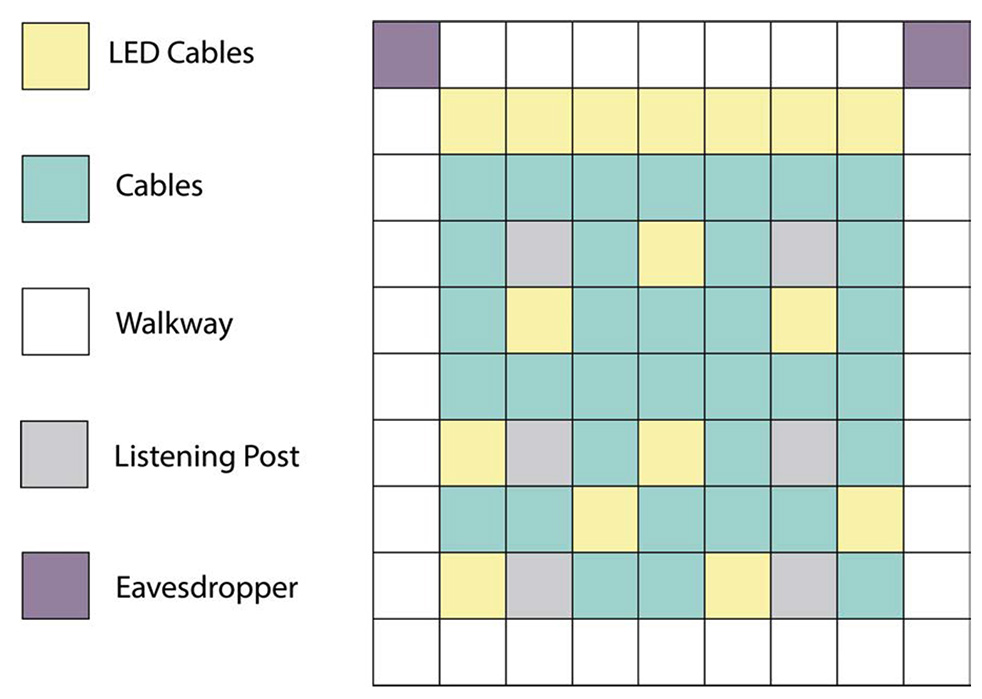Electrical Box (2016)
Electiral Box was an interactive sonic art installation exhibted in the CalArts WaveCave gallery in late 2016. The exhibit made use of the EavesDropper EM listening devices which are discussed at this location. The writing contained on this page is primarily adapted from my MFA thesis titled Electromagnetic Transluscence. To read my thesis and other publications check out the About page of this website. Otherwise, enjoy the writing segments included below =).
Electrical Box offers a silent room ordained with over one-thousand feet of instrument cables hanging from the CalArts WaveCave gallery’s ceiling rigging grid. Small, Light Emitting Diodes (LEDs) flicker at the ends of the cables suspended around the room. Several pairs of headphones hang in the far corners of the gallery. After walking to one of the corners of the gallery and equipping themselves with a pair of headphones, and the accompanying small metal tin, participants can hear faint static. As they explore the room, radio broadcasts can be heard emanating from the cables. The tins, or EavesDroppers, empower visitors with the ability to sonically explore the electromagnetic energy hidden within the cables hanging in the chamber.
Installation Interactions

Electrical Box guides visitors through a singular interaction rail while providing
minimal direction to the visitor. In an attempt to avoid granting explicit written or symbolic
instructions for how to interact with the installation, subtler methods were used to encourage
viewers to stay on rail. This included minimal signage, the acute placement of open space,
lighting, and strategic interface design.
The signage for Electrical Box functions as clues for visitors to uncover steps in the
interaction rail. A simple sign outside of the gallery only discloses the name of the installation
and that the installation is “electro-magnetic” and “interactive”. The information disclosed on
the sign is essential for helping visitors decouple the space’s expectations. Electro-magnetic hints
at the technology implemented while hopefully promoting an aura of danger and scientific
adventure. The word interactive informs the visitor of the participatory nature of the installation;
helping to ease them into a mindset of an active participant - assisting in steps II, III and IV.

Although the installation utilizes over one-thousand feet of cable, 35% of the gallery is designated as free space: void of cables, EavesDroppers, or any other clutter. The free space takes two forms: the walkways, or boarders, and the listening posts. The outside rows and columns of the grid, the frame, is left void of cables with the exceptions of the corners which house the EavesDroppers. The frame encourages viewers to enter into the space, approach the headphones, and to explore the room and functions as a walkway around the installation - assisting with steps I, II and V. This helps guide viewers through the interaction rail while softening the transition into the gallery by allowing intermediate commitment to the space. In addition to the frame, EB harbors nine listening ports which are also void of cables. The listening posts allow visitors to easily sample a variety of signals un-harassed by hanging cables - assisting with step V.

Exhibit Lighting
As Mandino and da Vinci foreshadow, EB embraces the darkness while using light sparingly as a
tool to show folks the way by guiding interaction. EB has three sources of light that participants
are exposed to inside the installation space: the cable LEDs, the door light, and the flood-lights.
At the terminus of each of the cables are white LEDs which echo the audio signal being
transmitted through the cables. These LEDs are the primary visual draw to most visitors due to
their flickering, and relative brightness, in the dim room. Seven LEDs
are concentrated in the rear of the installation followed by a single row with no light before the
remaining nine LEDs are distributed through the remaining space. The rear formation fabricates
a visual focal point which encourages visitors not only to enter into the space but to explore it -
assisting with steps I and II.
As the installation is relatively dark when compared to the hallway outside, when the
gallery doors are opened, the space is flooded with outside luminescence brighter than any
source of light found within the room. The large, heavy glass doors of the WaveCave gallery take
upwards of eight seconds to close creating a distinctive transition time into the gallery. This
eases the guests descent into relative darkness, hopefully smoothing the transition by helping the
eyes to adjust and simply giving the visitor time to acclimate to the new environment without
being fully committed to the space.
The final source of light in EB originates from two dim spotlights which are directed on
the headphones and EavesDroppers resting on glass shelves in the far corners of the gallery. The
spotlights are not bright enough to drastically change the overall ambience of the space, but do
provide enough illumination to focus attention on the headphones - assisting with steps II and
III.